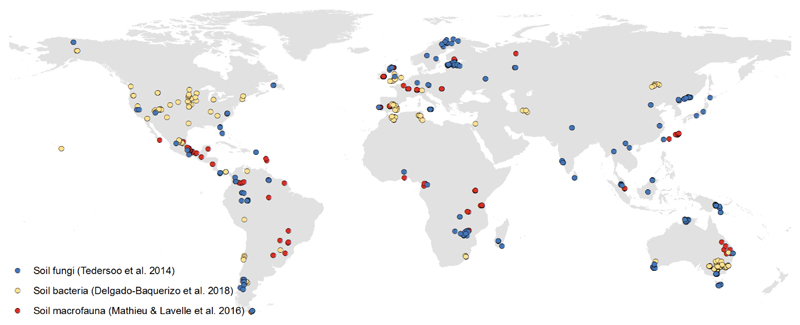To the Editor
Soil biodiversity represents a major terrestrial biodiversity pool, supports key ecosystem services, and is under pressure from human activities1. Yet, soil biodiversity has been neglected from many global biodiversity assessments and policies. This omission is undoubtedly related to the paucity of comprehensive information on soil biodiversity, particularly on larger spatial scales. Information on belowground species distributions, population trends, endemism, and threats to belowground diversity is important for conservation prioritization, but is practically nonexistent. As a consequence, much of our understanding of global macroecological patterns in biodiversity, as well as mapping of global biodiversity hotspots, has been based on aboveground taxa (such as plants2) and has not considered the functionally important, but less visible, biodiversity found in soil.
We mapped the study sites from existing global datasets on soil biodiversity (soil macrofauna3, fungi4, and bacteria5) to examine key data gaps worldwide (Fig. 1). Our map indicates significant gaps in soil biodiversity data remain across northern latitudes, including most of Russia and Canada. Data are also lacking from much of central Asia and central Africa (for example, the Sahara desert), as well as many tropical regions. The higher density of soil biodiversity sampling sites in Europe and the United States is similar to patterns observed for data on terrestrial bird, mammal, and amphibian species6, as well as plants7. Yet, in such aboveground datasets, the gaps in understudied regions are much less pronounced than in the soil biodiversity datasets shown here. The comparative lack of soil biodiversity data across these regions limits our ability to examine global macroecological patterns and to quantify potential mismatches between aboveground and soil biodiversity. The potential for such mismatches (areas with high aboveground diversity, but low soil biodiversity, or vice versa) may be substantial, as some evidence suggests that plant species richness declines more rapidly towards the North Pole than fungal species richness, which reaches a plateau4.
Fig. 1.
Global distribution of sampling sites for soil bacteria5 (yellow; n = 237), soil macrofauna3 (red; n = 2163), and soil fungi4 (blue; n = 326).
Soil ecologists are increasingly conducting their own large-scale assessments (such as the African Soil Microbiology Project8) and additional databases on soil biodiversity are beginning to be developed to address knowledge gaps9, in part through the Global Soil Biodiversity Initiative. However, increased efforts to fill these gaps and to compile additional global datasets on other soil taxa (for example, mesofauna) are needed to allow more detailed analyses of soil biodiversity at broad spatial scales. Of major concern is the lack of a global consensus on sampling strategies and methodological approaches to assess soil biodiversity, which in many cases, makes it challenging to compare datasets directly. Furthermore, greater cooperation with conservation biologists and policy makers is needed to better integrate soil biodiversity into global policies. For instance, soil biodiversity should be more explicitly considered in the post-2020 global biodiversity framework10 that will follow the Strategic Plan for Biodiversity 2011-2020 and in future assessments of the Intergovernmental Science-Policy Platform on Biodiversity and Ecosystem Services11.
These evident gaps in soil biodiversity data restrict our ability to develop policies to protect soil biodiversity. We argue that addressing these data gaps will ultimately benefit human well-being1 and provide an impetus for increased policy-relevant research on soil biodiversity.
Acknowledgements
We thank all contributors to the Macrofauna database, especially Emmanuel Lapied, George Brown, and Carlos Fragoso. We thank Mar Cabeza for helpful suggestions on an earlier version of this manuscript. We acknowledge support by the German Centre for Integrative Biodiversity Research (iDiv) Halle-Jena-Leipzig (funded by the German Research Foundation, FZT 118), the European Research Council (ERC Starting Grant 677232, ECOWORM), the Academy of Finland (285882), and the Natural Sciences and Engineering Research Council of Canada (postdoctoral fellowship to E.K.C.).
References
- 1.Orgiazzi A, et al., editors. Global Soil Biodiversity Atlas. Publications Office of the European Union; 2016. [Google Scholar]
- 2.Kreft H, Jetz W. Proc Natl Acad Sci. 2007;104:5925–5930. doi: 10.1073/pnas.0608361104. [DOI] [PMC free article] [PubMed] [Google Scholar]
- 3.Mathieu J, Lavelle P. In: Global Soil Biodiversity Atlas. Orgiazzi A, et al., editors. Publications Office of the European Union; 2016. [Google Scholar]
- 4.Tedersoo L, et al. Science. 2014;346:1256688. doi: 10.1126/science.1256688. [DOI] [PubMed] [Google Scholar]
- 5.Delgado-Baquerizo M, et al. Science. 2018;359:320–325. doi: 10.1126/science.aap9516. [DOI] [PubMed] [Google Scholar]
- 6.Meyer C, et al. Nature Communications. 2015;6:8221. doi: 10.1038/ncomms9221. [DOI] [PMC free article] [PubMed] [Google Scholar]
- 7.Meyer C, et al. Ecology Letters. 2016;19:992–1006. doi: 10.1111/ele.12624. [DOI] [PubMed] [Google Scholar]
- 8.Wild S, et al. Nat News. 2016;539:152. doi: 10.1038/539152a. [DOI] [PubMed] [Google Scholar]
- 9.Ramirez KS, et al. Front Ecol Evol. 2015;3:91. [Google Scholar]
- 10.CBD. 2017 https://www.cbd.int/doc/press/2017/pr-2017-12-16-sbstta-en.pdf.
- 11.IPBES. Global assessment. https://www.ipbes.net/deliverables/2c-global-assessment.



